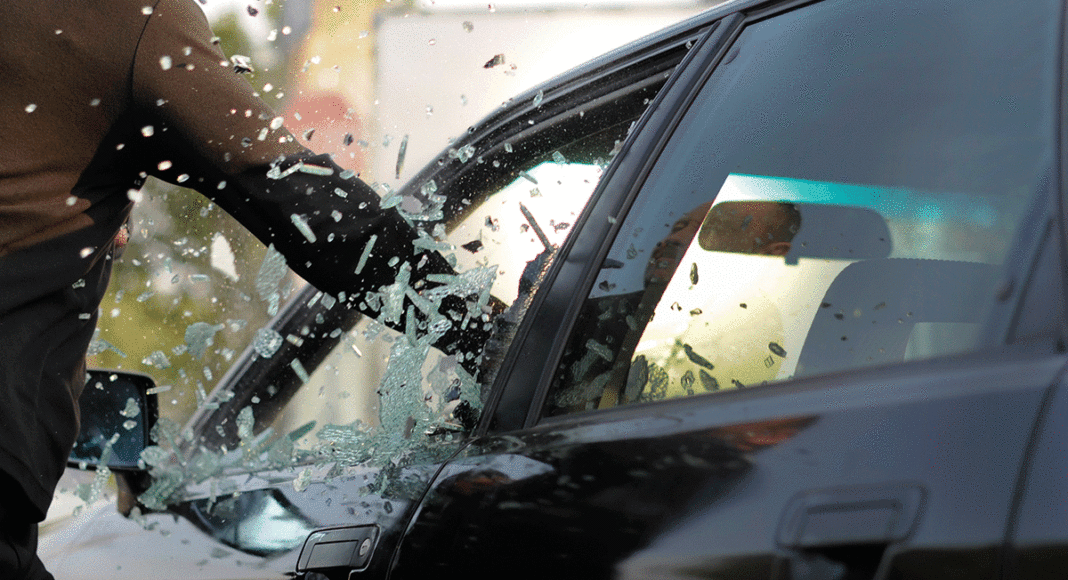From side streets in Seabright to the dirt parking lots that line the bluffs above remote beaches on Highway 1, it’s no secret that Santa Cruz has long been a hotspot for smash-and-grab car break-ins. Lately, though, some local auto glass shops have seen a surge in window repairs on cars where thieves appeared to target backpacks, cell phone chargers, spare change or—most frustrating for owners—nothing at all.
“It’s out of control,” said Annie Staub, who runs Action Auto Glass in Live Oak with her husband, Jason Hamilton. “We used to do a couple a week. Now we’re doing several a day.”
At Acumen Auto Glass in Soquel, a glass repair specialist who gave his name as Seth estimated that window repairs from auto thefts have jumped as much as 20 percent in the last two to three years.
“It’s always been steady, but it has escalated,” he says. “It’s all different types, all makes and models. Whoever’s in the right place at the right time.”
Though the Westside, Seabright and the stretch of Highway 1 between Santa Cruz and Davenport remain common targets, Staub says her business has seen a recent rash of break-ins on the UCSC campus. Several cars parked at the university’s Arboretum had windows smashed one day last week, staff confirmed to GT.
Car break-ins, along with petty theft of bikes and other misdemeanor property crimes, have been a frequent focal point for Santa Cruz public safety groups, and the subject of plenty of local law enforcement reports. In 2014, the Santa Cruz Police Department reported that vehicle burglary accounted for 42 percent of the city’s total crime.
Lately, official numbers tell a more mixed story. Reports of auto theft jumped in the fourth quarter of 2018, up 9 percent from the same period a year earlier, to 73 reported break-ins. When looking at the entire year, though, the Santa Cruz Police Department reported that the numbers actually dropped 28 percent from 2017 to 2018, from 362 reported auto thefts two years ago to 261 car break-ins last year.
Part of the discrepancy between anecdotal reports and official crime stats can likely be explained by reluctance on the part of some victims to report break-ins that will total a few hundred dollars or less, below most insurance deductible thresholds. A sense of futility about reporting such crimes to the police is another variable.
“Over $500, it’s always worth reporting,” says Seth of Acumen Auto Glass, since people who have lost items of higher value are more likely to be compensated in the still-unlikely event that a perpetrator is caught and has funds available. As for what he’s learned about customers recovering stolen items, “Whatever you have in your car, you better have a serial number.”
In the last year or so, reports about “epidemic levels” of car break-ins have reached pandemonium in the Bay Area, particularly in San Francisco. Concerned property owners and some politicians are quick to point fingers at the region’s increasingly glaring unsheltered homeless population, but investigations have documented burglary motives all over the map.
In Santa Clara County, the district attorney last year charged eight people with operating a “multimillion-dollar” international crime ring that involved stealing laptops and other electronics from cars throughout the Bay Area, then shipping them overseas to be resold on the black market in Vietnam. On this side of the hill, local police have also had to contend with periodic spikes in stolen cars, like the one day last spring when four stolen cars were recovered in Santa Cruz in 12 hours.
“You can see the motivation overall is kind of like helplessness, and not proactive to stop the problem,” Seth says.
SHATTERED PROOF
Online forums like Reddit, Yelp and Facebook offer no shortage of testimonials about expensive repairs for smashed windows in Santa Cruz. Locals off Ocean Street report backpacks with disc golf supplies snatched out of back seats. Tourists with out-of-state plates parked outside vacation rentals often make for easy marks.
How much unexpected window repairs will cost varies dramatically, from $130 or so for an easy-to-replace panel to $1,500 for one small triangular panel in the backseat of a Tesla, but sometimes they can run more than that, Seth says. Chrome moldings, rubber sealants and other small details can make a big difference in the tab drivers end up paying.
“Each individual piece of glass has its own history behind it,” he says. “The smallest little window in the car could end up being the most expensive to replace.”
At Staub’s shop, one of the most notable changes is how brazen break-ins have become.
“Now it’s happening in front of people’s offices in the middle of the day,” she says. “We do have some repeat people that unfortunately get broken into quite frequently, two or three times.”
Though the problem is easy to pinpoint, what to do about it isn’t as clear. Staub had one customer who reported a bottle of wine in the front seat that wasn’t touched. Those who opt to leave cars unlocked to discourage smashing windows have sometimes returned to find people who have let themselves in.
“There’s not a lot you can do,” she says says. “Don’t leave anything valuable. Don’t leave anything, really.”












